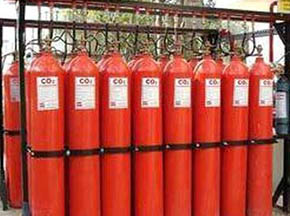
Carbon Dioxide is a colorless, tasteless, odorless gas that is found naturally in the earth’s atmosphere (approximately 0.03 % by volume at sea level). It is non-flammable, slightly acidic and is normally inert and non-toxic in nature. Carbon dioxide in Earth’s atmosphere is considered a trace gas currently occurring at an average concentration of about 400 parts per million by volume (or 591 parts per million by mass). The total mass of atmospheric carbon dioxide is 3.16×1015 kg (about 3,000 Gigaton). Its concentration varies seasonally and also considerably on a regional basis, especially near the ground. In urban areas concentrations are generally higher and in indoors, the gas can reach 10 times background levels. Carbon dioxide is a greenhouse gas (GHG).
The primary source of Carbon Dioxide in the manufacturing process is as an industrial by-product from Ammonia and petrochemical plants. Some major uses of Carbon Dioxide are the carbonation of soft drinks, freezing and cooling of food, using it as a cleaning agent in garment cleaning and food manufacturing industries as well as a fire extinguishing agent.
An unique feature of Carbon Dioxide is that it can exist simultaneously as a solid, liquid and gas at a temperature of -69.9oF at 60.4 psig (-56.6oC @ 416kPa). This is referred to as its triple point. Solid Carbon Dioxide (“Dry Ice”) at -109.3oF (-78.5oC) and at atmospheric pressure, transforms directly to a gas without passing through the liquid phase. Hence, it has become known as dry ice.
The primary hazard of Carbon Dioxide is asphyxiation. It can displace Oxygen and cause an Oxygen deficient atmosphere. Just one or two breaths in an atmosphere of 4% or less Oxygen can cause immediate unconsciousness without warning. It is one and a half times heavier than air and may accumulate in low or confined areas. Carbon Dioxide has a Threshold Limit Value (TLV) of 5000 ppm (0.5%) Time Weighted Average (TWA8) and a Short Term Exposure Limit (STEL; 15 minutes) of 30,000 ppm (3%). There must always be adequate ventilation to ensure that there is no exposure above these limits. Carbon Dioxide is not classified as toxic or harmful in accordance with Globally Harmonized System (GHS) of Classification. In concentrations up to 1% (10,000 ppm), it can make some people feel drowsy. Concentrations of 7% to 10% may cause suffocation, even in the presence of sufficient Oxygen, manifesting as dizziness, headache, visual and hearing dysfunction, and unconsciousness within a few minutes to an hour. The physiological effects of acute Carbon Dioxide exposure are grouped together under the term hypercapnia.
Since it is heavier than air, in locations where the gas seeps from the ground (due to sub-surface volcanic or geothermal activity) in relatively high concentrations, without the dispersing effects of wind, it can collect in sheltered/pocketed locations below average ground level, causing animals located therein to be suffocated. Carrion feeders attracted to the carcasses are then also killed. Children have been killed in the same way.
Although the body requires Oxygen for metabolism, low oxygen levels normally do not stimulate breathing. Rather, breathing is stimulated by higher Carbon Dioxide levels. As a result, breathing low-pressure air or a gas mixture with no Oxygen at all (such as pure Nitrogen) can lead to loss of consciousness without ever experiencing “hunger”. Another hazard is related to the cold temperatures of liquid Carbon Dioxide and dry ice. Contact between the skin and liquid CO2 must be avoided. Dry ice must be handled with tongs or heavy gloves.
CATEGORY AND DETAILS
Chemical Name :- Carbon dioxide
Specification
IS 307:1966
Offered Purity
The purity is 99.5%
Cylinder Colour
Black with white or aluminium band on the shoulder
Packaging
The cylinders are available in 47 liters water capacity and 30 Kg CO2 is fiiled in liquid form.
Application
Carbon Dioxide is used for refrigeration and cooling process in both liquid and solid forms. Used as an inert gas in chemical processes, in the storage of carbon powder and in fire extinguishers.CO2 is used for red fume suppression during scrap, carbon charging and ladle transfer of matter (Cu/Ni production) or bullion (Zn/Pb production). CO2 is used in the manufacture of casting molds to enhance hardness.
Read More